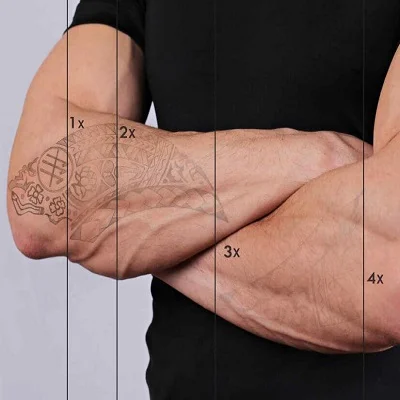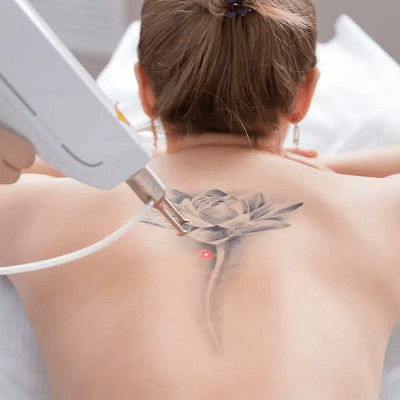Laser tattoo removal is an effective way to erase unwanted tattoos, but like any medical procedure, it carries some risk of complications, including infections. Knowing how to spot an infection after Laser tattoo removal(إزالة الوشم بالليزر) and what to do can make all the difference in preventing further issues and ensuring proper healing. In this article, we’ll guide you through the signs of infection, the steps to take if you suspect one, and how to care for your skin during the recovery process.
Page Contents
Common Signs of Infection After Laser Tattoo Removal:
After undergoing laser tattoo removal, the skin will go through a healing process that can take several weeks. While some redness, swelling, and scabbing are normal, certain symptoms may indicate an infection. Recognizing these signs early on can help prevent the infection from worsening and avoid complications.
Redness and Swelling Beyond Normal:
- Mild swelling and redness around the treatment area are common right after the procedure, but if these symptoms persist or worsen over the following days, it could be a sign of infection.
- Increasing discomfort: If the area becomes increasingly painful or tender, this could also indicate an infection, especially if it feels warm to the touch.
Unusual Discharge or Pus:
- Pus or yellowish fluid oozing from the treated area is a clear sign of infection.
- If the wound becomes excessively moist or sticky, this could point to bacterial growth, requiring immediate attention.
Fever and Chills:
- A fever, often accompanied by chills, may develop as the body tries to fight off an infection. If you experience these symptoms, it’s essential to seek medical advice promptly.
Increased Redness or Darkening:
- Darkened skin around the tattooed area or redness that spreads beyond the expected region may signal an infection.
- Skin that feels hard or tight can indicate inflammation or infection under the surface, which could be a more serious concern.

How to Care for Your Skin After Laser Tattoo Removal?
Proper aftercare is crucial to prevent infections and promote healing after laser tattoo removal. It’s important to follow the aftercare instructions provided by your tattoo removal specialist to ensure the skin heals correctly and without complications.
Keep the Area Clean and Dry:
- Gentle washing: Clean the treated area with lukewarm water and mild, fragrance-free soap. Avoid scrubbing or using abrasive materials on the skin.
- Pat dry: After washing, gently pat the area dry with a clean towel to avoid irritating the skin or disrupting the healing process.
Apply Antibiotic Ointment (If Recommended):
- In many cases, a light layer of antibiotic ointment like Neosporin can help prevent infection by creating a barrier over the wound.
- Always use a clean applicator (such as a cotton swab) to avoid introducing bacteria from your hands.
Avoid Scratching or Picking at the Skin:
- The skin will likely form scabs or blisters during the healing process. It’s important to avoid picking at the scabs or blisters, as this can introduce bacteria and increase the risk of infection.
What to Do If You Suspect an Infection?
If you notice any signs of infection after your laser tattoo removal, it’s important to act quickly. Taking the right steps can prevent the infection from worsening and ensure proper healing.
Contact Your Tattoo Removal Specialist:
- Reach out to your specialist: If you notice signs of infection, your first step should be to contact the clinic or professional who performed the procedure. They can assess the situation and provide specific guidance based on your case.
- Follow up appointments: Sometimes, follow-up consultations may be necessary to assess the healing process and ensure there are no complications.
Seek Medical Attention:
- If the infection appears severe or if you experience a fever, it’s essential to consult a doctor immediately. In some cases, a prescription for oral antibiotics may be required to treat the infection and prevent it from spreading.
Keep the Area Clean and Covered:
- If advised by your doctor or specialist, you may need to cover the treated area with a sterile bandage or dressing to protect it from dirt and bacteria while it heals.
- Change the dressing as instructed to ensure the area remains clean and dry.
The Role of Hydration and Nutrition in Healing:
Good overall health plays a vital role in your skin’s ability to heal after laser tattoo removal. Hydration and nutrition can support the skin’s recovery process and reduce the chances of complications, including infection.
Stay Hydrated:
- Drinking plenty of water helps keep your skin hydrated, which is essential for tissue repair and overall healing.
- Avoid alcohol during the healing process, as it can dehydrate the skin and impair the healing process.
Eat a Balanced Diet:
- Consume vitamin-rich foods: Vitamins A, C, and E support skin health and help with the healing of wounds. Include a variety of fruits, vegetables, and lean proteins in your diet to provide your body with the nutrients it needs.
- Avoid processed foods: High-sugar or processed foods can contribute to inflammation and slow down the healing process, making the skin more vulnerable to infection.
Preventing Infection During the Healing Process:
Infections can be avoided with the right aftercare and a few preventive measures. By keeping the treated area clean, avoiding irritating substances, and following your specialist’s advice, you can significantly reduce your chances of developing an infection.
Protect the Area from Sun Exposure:
- Avoid direct sunlight on the treated area for at least a few weeks after your laser tattoo removal session, as the skin will be more sensitive and vulnerable to damage.
- Use a broad-spectrum sunscreen (SPF 30 or higher) once the skin has healed enough to prevent pigmentation changes.
Wear Loose Clothing:
- Avoid tight clothing that can rub against the treated area and cause irritation or increase the risk of infection.
- Opt for soft, breathable fabrics like cotton, which will allow the skin to heal without causing friction.
Follow a Strict Aftercare Regimen:
- Adhere to the aftercare instructions provided by your specialist, including the use of ointments, dressings, and avoiding exposure to contaminants.
- Be sure to attend follow-up appointments to ensure the skin is healing correctly and there are no early signs of infection.
When to Seek Professional Help?
While minor irritation and redness are expected after laser tattoo removal, it’s essential to know when professional help is needed. If you experience any of the following symptoms, you should seek medical or professional assistance immediately:
- Persistent or worsening redness or swelling.
- Yellow or greenish discharge from the wound.
- Fever or chills, indicating a systemic infection.
- Severe pain or signs of an abscess forming.
Your healthcare provider or tattoo removal specialist will be able to evaluate the situation and determine the most appropriate course of action, which may include prescription medications or further treatment.
In conclusion, while infections after laser tattoo removal are rare, they can occur, and it’s crucial to spot the early signs and take action immediately. Proper aftercare, including keeping the area clean and following specialist instructions, plays a significant role in preventing complications. If you notice signs of infection, don’t hesitate to seek professional advice or treatment to ensure a smooth and successful healing process.




